
PREV ARTICLE
NEXT ARTICLE
FULL ISSUE
PREV FULL ISSUE
SELECTIONS FROM NUMISMATICA ARS CLASSICA #99-100Shanna Schmidt submitted these thoughts on some lots coming up in the sales by Numismatica Ars Classica of Zurich. Thanks! I've added links, images, and excerpts from the catalog
descriptions. -Editor
Shanna writes: Here are just some of the fantastic pieces coming up at the NAC auction on May 29-30. I’ve only highlighted some of the coins. The biggest thing I noticed is that most of the major “star” pieces in ancient numismatics exist in this sale and there are several six figure coins. The only significant coin that it didn’t have from my mind is an EID MAR, otherwise, pretty much everything that gets people excited in Greek and Roman coinage is there. Auction 99 is the second part of the George LaBorde collection. This group of 50 aureii completes the sale of Mr. LaBorde’s coins. He collected only aureii and purchased several with significant pedigrees which makes the collection very exciting. Here are a few of the notable coins Lot 5: Galba Aureus
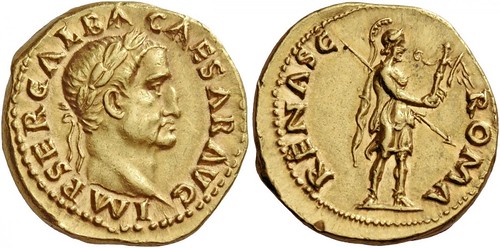 Galba, 68 – 69. Aureus July 68-January 69, AV 7.31 g. IMP SER GALBA CAESAR AVG Laureate head r. Rev. ROMA RENASC Roma, helmeted and in military attire, standing r., holding Victory on globe and transverse spear. C 199. RIC 198. BMC –. Calicó 491 (this coin illustrated). Extremely rare and in exceptional condition for the issue. A very appealing portrait perfectly struck and centred on a full flan and an interesting reverse composition. Good extremely fine This coin is illustrated on the back cover of David R. Sear’s, Roman Coins and Their Values: Vol. I. To read the complete lot description, see:
Lot 32: Aurelian Aureus
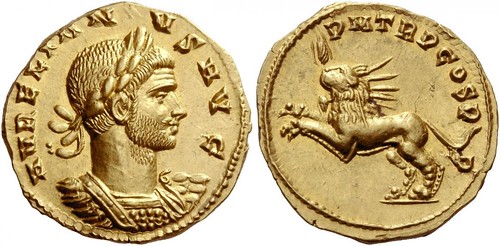 Aurelian, 270 – 275. Aureus, Cyzicus early 272, AV 4.84 g. AVRELIAN – VS AVG Laureate and cuirassed bust r., with slight drapery on l. shoulder. Rev. P M TR P COS P – P Radiate lion leaping l., holding thunderbolt in its jaws. C –. RIC 159 (Siscia). Göbl Aurelianus, 129An2 and pl. 75 (Roma, this reverse die). CBN p. 416 and pl. 85, 259 (this reverse die). Calicó 4022 (this coin). Extremely rare and possibly the finest specimen known. An important and interesting issue with a spectacular reverse type. Virtually as struck and almost Fdc To read the complete lot description, see:
Lot 44: Carausius Aureus
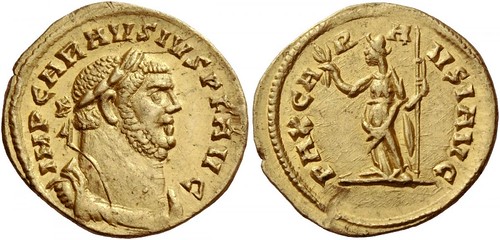 Carausius, 286 -293. Aureus, Londinium October 286-March 287, AV 4.20 g. IMP CARAVSIVS P F AVG Laureate, draped and cuirassed bust r. Rev. PAX CA – R – A VSI AVG Pax standing l., holding olive branch and vertical sceptre. C –. RIC 5. Depeyrot 2/5. Shiel 4. Calicó 4782. Of the highest rarity, apparently the second specimen known. An unusually attractive portrait struck on a full flan, minor mark on reverse field at seven o’clock, otherwise good extremely fine / extremely fine To read the complete lot description, see:
Shanna writes: Auction 100 is a marvelous sale with countless Greek and Roman highlights. Just a few highlights are lot 24, a signed tetradrachm from Akragas, lot 87, a Naxos tetradrachm, lot 96, a Sicily, Syracuse signed tetradrachm, lot 99, 100 and 102 are three beautiful dekadrachms of Syracuse (two are signed). Lot 126 is a didrachm from Samothrace that comes from the Kunstfreund collection and is from an early hoard. Lot 134 is an Athens dekadrachm. These normally are not available and authenticity can be questionable. This one is certainly from the hoard that was found in Turkey in the 1980’s. A number of European and American dealers (including my father, Harlan Berk) got parts of this hoard. In the end the Turkish government had all the coins returned and some of them did not make it back to Turkey and were put away. None of this is a secret. It was highlighted in a July 1988 Connoisseur magazine article (I have a copy of the article should you want it). Lot 134 is certainly the coin that my father did not return and was noted in the article. The question of authenticity is therefore very small. Lot 148 is a fantastic electrum stater that is a duplicate from the Hermitage museum in St. Petersburg. Lot 170 is a First Revolt year 5 shekel of which only a handful exist. Lot 87: Naxos Tetradrachm
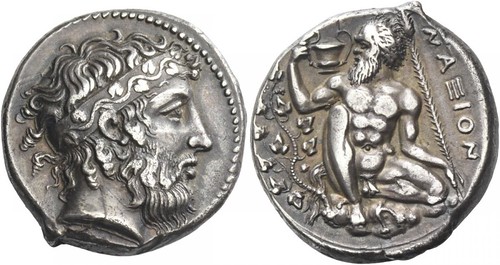 Naxos. Tetradrachm, circa 415, AR 17.14 g. Bearded head of Dionysus r., hair bound with stephane adorned with ivy-wreath. Rev. Bearded, naked Silenus, with pointed ears, ruffled hair and long tail, squatting on rock, facing; r. leg raised and l. folded to the side. He turns l. towards cantharus in his r. hand, while holding thyrsos in his l. In l. field, ivy plant creeps upward, behind which his long tail is visible; to r., NAΞION. Rizzo pl. XXX, 1 (this reverse die). Jameson 677 (these dies). Gulbenkian 232 (these dies). SNG Fitzwilliam 1113 (these dies). Dewing 663 (this obverse die). Very rare and among the finest specimens known of this spectacular and desirable issue. A wonderful portrait in full Classical style and a very appealing reverse composition. Perfectly struck and centred on a full flan and with a magnificent old cabinet tone. Extremely fine To read the complete lot description, see:
Lot 102: Syracuse Decadrachm signed by Euainetos
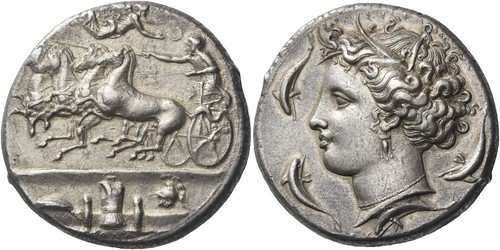 Syracuse. Decadrachm signed, by Euainetos circa 400 BC, AR 42.71 g. Fast quadriga driven l. by charioteer, holding reins and kentron; in field above, Nike flying r. to crown him. In exergue, display of military harness set on two steps and below l., [Α]ΘΛΑ. Rev. ΣΥ – ΡΑ – Κ – [Ο – ΣΙΩΝ] Head of Arethusa (Kore-Persephone) l., wearing barley-wreath, triple pendant earring and beaded necklace. Around three dolphins, while a fourth makes dorsal contact with neck truncation; beneath, EY – AINE. SNG Copenhagen 689 (this reverse die). Dewing 880 (these dies). Gallatin C.IV/R.III. Rare. A superb specimen of this desirable issue. Struck on a very broad flan and with a light iridescent tone. Extremely fine Ex Tkalec sale 8 September 2008, 20.
To read the complete lot description, see:
Lot 134: Attica Athens Decadrachm
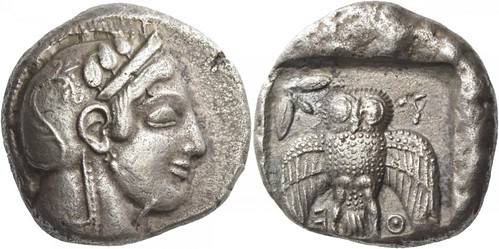 Attica, Athens. Decadrachm, circa 467-465, AR 41.98 g. Head of Athena r., wearing crested helmet, earring and necklace; bowl ornamented with spiral and three olive leaves. Rev. A – Θ – E Owl standing facing, with spread wings; in upper field l., olive-twig with two leaves and berry. The whole within incuse square. ACGC 188. Starr Group II C 61 (this obverse die). Svoronos pl. 8, 14 (this obverse die). Seltman pl. XXI, A 207 (this die). Kraay-Hirmer 358 (this obverse die). Fischer-Bossert The Athenian Decadrachm 28a (this coin). Extremely rare and of the highest numismatic and historical interest, undoubtedly one of the most prestigious Greek coins. Metal slightly porous and a die-break on obverse, otherwise good very fine / about extremely fine Ex Berk 109, 1999, 191 and NAC 39, 2007, 41 sales. Athens decadrachms rank high among the prizes of ancient Greek coinage, with few examples existing in public or private collections. The purpose of these massive coins, and their dating, has long excited debate among scholars. In recent years a careful study of hoard evidence has shattered some enduring myths, and these coins are now attributed to a period of perhaps several years in the mid-460s B.C., making them contemporary with the ‘Demareteion’ decadrachms of Syracuse. To read the complete lot description, see:
From the Roman section there are numerous coins that are interesting but a few highlights are: lot 374 (P. Clodius M.f. Turrinus aureus), lot 401 a cistophoric tetradrachm of Marc Antony and Cleopatra, lot 460 a sestertius of the Colloseum in Rome, lot 478 which is a fabulously struck Hadrian/divus Trajan aureus. Lot 549 and 555 are two perfect aurei from the Severan dynasty. There are also a few impressive large denomination solidii such as lot 637 (Medallion of Constantine I). Lot 690 is an unimprovable solidus of Procopius. Finally lot 725 is an exceedingly rare solidus Licinia Eudoxia which has a pedigree going back to 1924 Lot 374: Turrinus Aureus
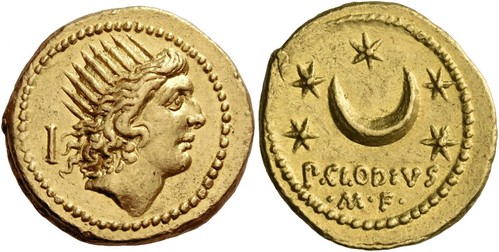 P. Clodius M.f. Turrinus. Aureus 42, AV 8.19 g. Radiate head of Sol r.; behind, quiver. Rev. P·CLODIVS / M·F Crescent surrounded by five stars. Babelon Clodia 16. Bahrfeldt 31. Sydenham 1114a. Sear Imperators 181a. Crawford 494/20a. Calicò 9. Very rare and in exceptionally good condition for the issue, undoubtedly among the finest specimens known. Struck on a very broad flan and perfectly centred. Extremely fine / good extremely fine To read the complete lot description, see:
Lot 460: Divu Titus Sestertius
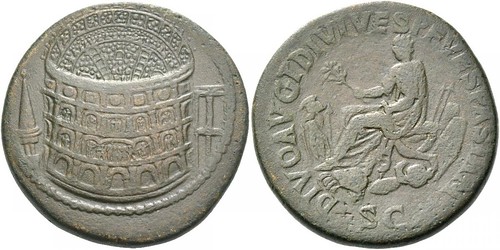 Titus, 79 – 81. Divu Titus. Sestertius 81-82, Æ 25.92 g. Aerial view of the Flavian amphitheatre (the Colosseum); on l., Meta Sudans and on r., porticoed building. Rev. DIVO AVG T DIVI VESP F VESPASIAN Titus seated l. on curule chair, holding branch and roll; around, arms; below, S – C. C 399. BMC 191 note. RIC Domitian 131. CBN Domitian 543. Elkin, NC 2006, p. 217, 9. Extremely rare, only the eleventh specimen known of this prestigious and important issue, which is much more rare with Titus as Divo rather than Emperor. A very detailed and clear obverse composition and a pleasant brown-green patina. As usual weakly struck on reverse, otherwise about extremely fine / very fine From the Aba Neeman collection.
Vespasian was still alive when the first three levels of his colosseum were completed and dedicated in 75. However, the final product – including the fourth and fifth levels, which are clearly represented on this sestertius – was not finished for another five years, at which point it was formally dedicated by his eldest son Titus in June, 80. The engraver went to great effort to represent the Colosseum in detail. Not only are the statues and other ornaments on the exterior shown with considerable clarity, but the interior is well represented down to the smallest features, such as spectators, staircases and what we must presume is the viewing box reserved for the emperor. Flanking the amphitheatre on the right is the Meta Sudans fountain and an uncertain structure that has been identified as the Baths of Titus, the porch of Nero’s Golden House (Domus Aurea), or perhaps a temple. I've always been fascinated by architecture pictured on ancient coins, and this is the king of the series due to its famous subject. Although we're quite lucky much of the
Colosseum still stands, often our only glimpse of ancient structures is from their depictions on coins. -Editor
To read the complete lot description, see:
Lot 637: Constantine I Medallion of 1 1/2 Solidi
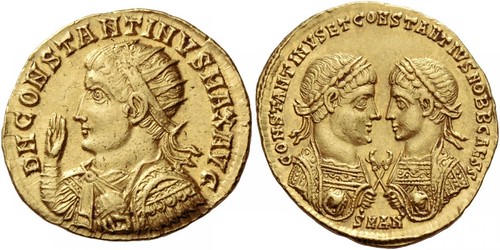 Constantine I, 307 – 337. Medallion of 1 1/2 solidi, Antiochia 326, AV 6.59 g. D N CONSTANTINVS MAX AVG Radiate, draped and cuirassed bust l., raising r. hand and holding globe in l. Rev. CONSTANTINVS ET CONSTANTIVS NOBB CAESS Confronted laureate busts of Constantine II and Constantius II, each wearing consular trabea and holding eagle-tipped sceptre in one hand and globe in the other; in exergue, SMAN. RIC 70. Gnecchi p. 23, 1 and pl. 8, 15. Alföldi 63. Toynbee p. 197. Kent-Hirmer pl. 162, 643. Depeyrot p. 155. Bastien, Donativa, p. 79 note 13. Of the highest rarity, the finest of only three specimens known of this fascinating issue. Well struck on a broad flan and about extremely fine / extremely fine Ex Sternberg XXIX, 1995, 528 (illustrated on the front cover page); Triton I, 1997, 1698; NAC 24, 2002, European Nobleman, 279 and NAC 54, 2010, 616 sales. Taking a page from the Severan numismatic playbook of the early third century, this fabulous gold medallion serves to illustrate Constantine the Great’s concern for the welfare of the late Roman Empire. It advertises his sons, Constantine II and Constantius II, as Caesars (i.e. junior emperors) who would succeed him when he died and carry on the established administration. In short, the medallion presents an image of dynastic stability and implies a smooth transition of power from one ruler to his sons, thereby sparing the exhausted Roman people of yet another destructive civil war. This was important to emphasize since the Tetrarchic system, introduced by Diocletian and Maximianus to solve the same problem in A.D. 286 was ultimately a failure that plunged the Roman world into a series of civil wars between A.D. 309 and 324. The types here attempt to convince us that the tried and true method of smooth dynastic succession from father to sons would save the day in the end. The medallion was struck, perhaps not coincidentally, almost 125 years after the dynastic series of Septimius Severus. Constantine the Great’s radiate crown seems to be a deliberate throwback to the third century. This medallion was probably distributed as largesse to the army on the occasion of Constantine’s vicennalia (twentieth anniversary as emperor) celebrations that began in mid-A.D. 325 and continued until the final celebration at Rome in July of A.D. 326. In A.D. 326, Constantine the Great shared the consulship with Constantius II for the first time and it is for this reason that the latter is depicted here wearing ornate consular robes and holding the eagle scepter of office. Constantine II had previously served as consul with his father and therefore also appears in his consular attire to complete the symmetry of the reverse type. To read the complete lot description, see:
That's a freakishly small hand. For our friends in London, wave hello to Shanna this week as she visits to review auction lots. Here's her note from her Newsletter #15
published May 5, 2017. -Editor
London trip (May 9-12) I arrive in London on Tuesday and was fortunate enough to have a good friend put me up (thank you good friend….you know who you are!). I’ll spend a majority of my time viewing NAC lots and I also will pop by and visit my friends at Roma, Sovereign Rarities and London Coin Galleries. Additionally if time permits there is an interesting small sale of coins at Morton & Eden and I will try to get in there to view those pieces. To visit Shanna's web site:
 Wayne Homren, Editor The Numismatic Bibliomania Society is a non-profit organization promoting numismatic literature. See our web site at coinbooks.org. To submit items for publication in The E-Sylum, write to the Editor at this address: whomren@gmail.com To subscribe go to: https://my.binhost.com/lists/listinfo/esylum All Rights Reserved. NBS Home Page Contact the NBS webmaster 
|